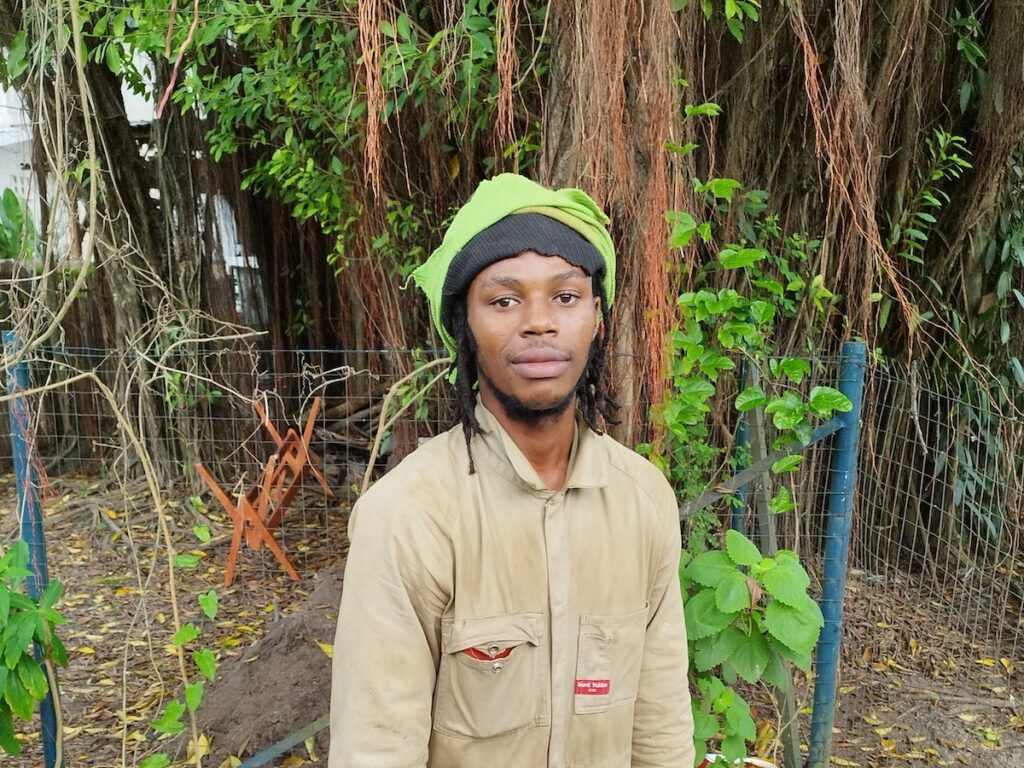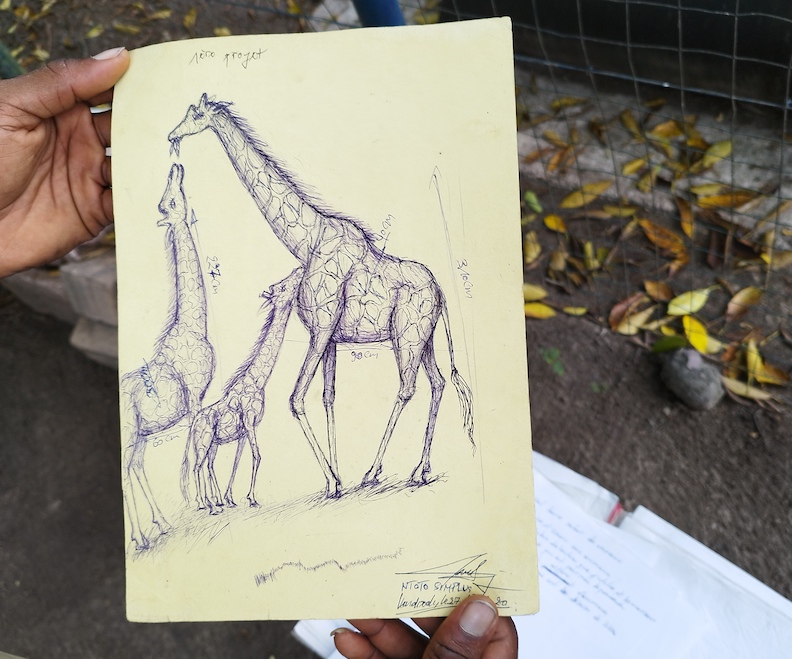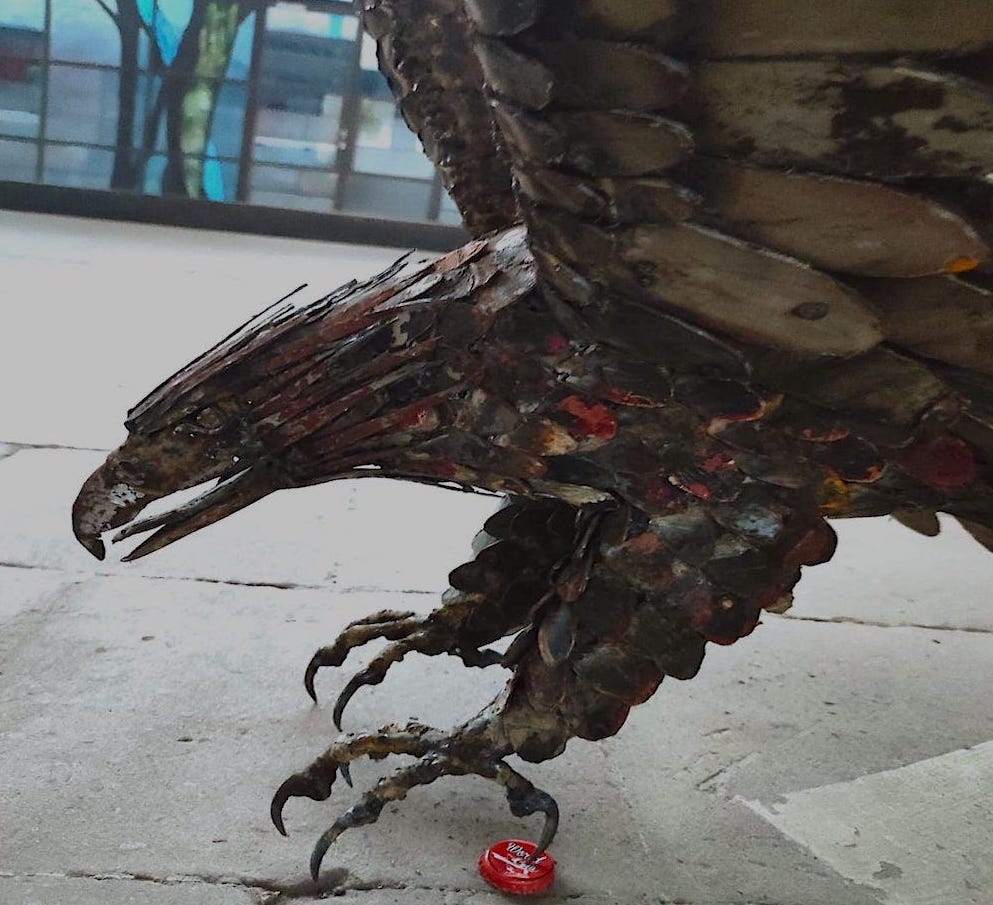Art has the power to shape perceptions, challenge norms, and touch hearts. In today’s exclusive interview, we get up close and personal with one such extraordinary artist. Introducing Simplus Ntoto, a man turning discarded car shells into breathtaking animal sculptures and, in the process, redefining the landscape of contemporary sculpture. Let’s delve into the inspiring journey of this talented artist from Kinshasa.
Artistic Journey & Technique
Kitokongo: Mbote Simplus! It’s an absolute pleasure to have this conversation with you. Could you start by telling us a little about yourself, your early days, and how you found your passion for the arts?
Simplus Ntoto: Thank you for visiting me in my atelier. Well, my journey into the world of art began in Kinshasa, where I was born on May 5, 1998. After completing my primary and secondary education, I pursued my passion at the Academy of Fine Arts of Kinshasa, where I graduated in 2021. I was drawn to the arts from a young age, around 13, when I discovered my love for drawing and painting. However, it was in 2016 when I chose the challenging path of becoming a sculptor. Shortly after graduating from the Academy of Fine Arts in 2018, I embarked on my professional career. My goal was to bring something unique to the world of sculpture. I chose to create sculptures from car shells, which is not a conventional material in the field.

My goal was to bring something unique to the world of sculpture.
Kitokongo: That’s fascinating. We usually see sculptures made from clay, wood, or bronze. What made you choose car shells?
Simplus Ntoto: During my studies at the academy, I learned the traditional techniques of sculpture, while my internship with Maitre Mbikou taught me how to weld. However, using old metal sheets and welding to shape them into sculptures was something I taught myself. I wanted to do something different, more challenging, and showcase my skills and competencies in a remarkable way.
Inspiration & Creation Process
Kitokongo: It is quite remarkable that you have developed your own sculpting technique. Can you tell us more about your creative process?
Simplus Ntoto: Of course. My process starts with researching images of animals found in the Congolese national park. Once I feel a connection with a particular animal, I draw it with careful attention to detail. Then I build a frame or ‘skeleton’ of the chosen animal. The next step involves getting the car shell, cutting it into pieces, shaping each piece, and welding it to the frame.

Kitokongo: Your work displays a sense of movement with perfect symmetries, which must be complex to achieve with a material like car shells. Do you study the anatomy of the animals before you start?
Simplus Ntoto: While the anatomy of the animal is important, I don’t rely on it to create the dynamism in my sculptures. Instead, I focus on observing the animal and understanding its movements. This observational process allows me to form a spiritual connection with the animal, enabling me to recreate its essence through my work.
This observational process allows me to form a spiritual connection with the animal, enabling me to recreate its essence through my work.
Kitokongo: Speaking of which, are there any animals you feel a stronger spiritual connection with?
Simplus Ntoto: I feel a particular connection with leopards and eagles. I identify with the courage and confrontational nature of the leopard as well as the eagle’s quest for perfection and its eye for details. These attributes also reflect in my work and life goals.

I identify with the courage and confrontational nature of the leopard as well as the eagle’s quest for perfection and its eye for details.
Impacts & Future Goals
Kitokongo: Your recent exhibition at Texaf Bilembo was a resounding success with most of your works being sold in the first few days. How do you feel about this reception to your art?
Simplus Ntoto: It was indeed a humbling experience to see such a response. The exhibition featured 15 new artworks that were the result of 9 months of meticulous work. I believe that people could see the dedication and care that went into creating each piece.
Kitokongo: Absolutely, your dedication clearly shines through your work. As an organization, we at Kitokongo aim to empower artists and artisans. What advice can you give us to support young artists better?
Simplus Ntoto: Visibility is a significant issue for young artists. It’s not easy to sell artwork without the right contacts, and it’s equally challenging to make those contacts when starting. Galleries often focus on established artists, making it harder for emerging ones. If Kitokongo can help bridge this gap, it would make a huge difference.
Kitokongo: We are up for the challenge and we’ll work tirelessly towards achieving this. Lastly, any words of wisdom for the beginners in the field of art and sculpture?
Simplus Ntoto: Patience, passion, and persistence are key. As a young artist, you will face many difficulties, but those who persevere will eventually succeed.
Patience, passion, and persistence are key.
Kitokongo: Thank you for this enriching conversation, Ntoto. Your journey is truly inspiring.
Simplus Ntoto: The pleasure was mine. Thank you for providing this platform to share my story and experiences.
The Artist in Action
The interview was closing to an end, but not without a final request from our end. Curiosity led us to ask Ntoto to show us a glimpse into his world, a live demonstration of his work process.
Nodding in agreement, he began to prepare. He swapped his casual attire for his work clothes, his artist’s uniform. A sturdy pair of shoes replaced the casual ones. His eyes, hidden behind the protection glasses, shone with an intensity that mirrored his passion.

At his side, his faithful companions: a welding machine powered by electricity, an angle grinder and his hammer. The raw material, a piece of metal, lay unassuming, waiting to be molded into the form Ntoto envisioned.
The process began with him skillfully shaping the piece of metal by sawing and hammering it into the desired form. It was then welded to the frame, slowly but steadily breathing life into his vision.
Reflections & Conclusion
As I watched this spectacle unfold, I was struck by the complexity and meticulousness of his work. This was physically demanding, requiring not just artistic skills, but also a mastery of craftsmanship.
Despite the demonstration, the magic behind his detailed creations remained a mystery. How could such intricate detail be reproduced with just a hammer and a welding machine, especially in his smallest creations? The answer was as elusive as ever.
In that moment, it became abundantly clear that Ntoto’s art was not just a product of his talent, but also his tireless dedication, ceaseless curiosity, and an unwavering desire to defy the norm.
This is the end of the blog post. Thank you for accompanying us on this journey into the world of Simplus Ntoto. We hope you found it as engaging and inspiring as we did. Until our next encounter, we encourage you to explore our other blog posts and consider subscribing to our newsletter. With each new interview, we strive to bring you stories that stir the imagination and inspire the soul.

Comments